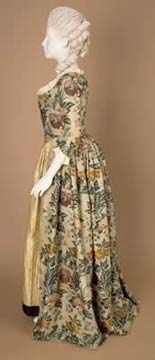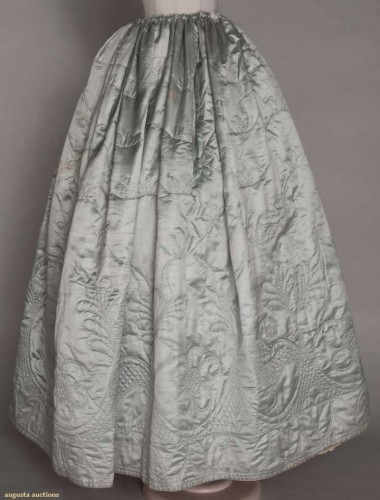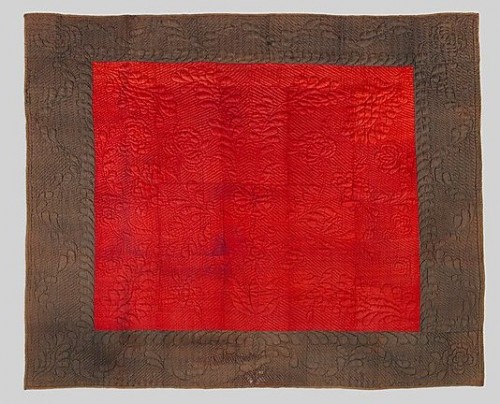Calamanco (also spelled callimanco, calimanco, and kalamink) is a thin fabric of worsted wool yarn which could come in a number of weaves: plain, satin, damasked, and was even brocaded in floral, striped and checked designs. The surface was glazed or calendered (pressed through hot rollers).
References to calamanco go back to the late 16th century, but calamanco’s heyday was from the end of the 17th century to the end of the 18th century. It was a popular fabric for women’s gowns and petticoats and men’s waistcoats, though it was gradually replaced by cotton and linen calico as a dress fabric.

Open gown with a petticoat of quilted silk, lined with calamanco, mid-late 18th century, Liverpool Museum
Daniel Defoe mentions a petticoat of black calamanco in 1720, and they remained popular among the rural populace until the early 19th century. He also describes the wardrobe of the ‘poorest countryman’ in England and notes his ‘waistcoat of calimanco from Norwich.’
At least in the beginning of the century, calamanco wasn’t confined to the common man’s waistcoat. The Tatler in 1709 describes the wardrobe of the ‘Dapper’.
The habit of a Dapper when he is at home, is light broadcloth, with calamanca or red waistcoat and breeches and it is remarkable that their wigs seldom hide the collar of their coats.
Since the Dapper is also described at being most at home in the country, we can assume that the Tattler is describing more of a casual country gentleman than the type of man that we envision as a modern day dapper.
Most calamanco was produced in Norwich in England, and exported from there throughout England, and to the Colonies.
Unfortunately, because calamanco was often used for simple petticoats and working clothes, there aren’t very many extant garments. The Norfolk Museum has at least two pieces, a blue brocade calamanco from ca. 1765, and a striped piece from between 1750-1800, but alas, does not have images of them online. Meg Andrews has a striped petticoat that she describes as being similar to the ones at the Norfolk Museum, but it’s not entirely clear if her petticoat is also calamanco. The Manchester Galleries have a petticoat with a calamanco hem, but their photograph doesn’t show that part of the petticoat.
Most extent calamanco pieces are either quilts, or the linings of quilted silk petticoats, where the cheaper calamanco fabric would provide warmth beneath the more fashionable silk exterior.
As the century progressed, not only did calamanco become less and less fashionable, even among the working classes, its definition became less and less defined. The glazed surface was such a common characteristic of calamanco fabrics that ‘calamanco’ eventually referred to a range of wool and wool blend fabrics with glazed surfaces. These fabrics were often used in quilts, particularly in North America.
Apparently, because calamanco was so often striped, striped tabby cats were sometimes called calamanco cats, though this may also have been a confused regional variant based on the similarities between the words ‘calico’ and ‘calimanco’ and the term for a calico cat. Construction finishes with plaster and timber alternating were also called calamanco-work.
For a bit of a history of the use of calamanco in quilts check out this article.
Sources:
Andrews, Meg. Norwich Woollens or Stuffs. Retrieved from http://www.meg-andrews.com/articles/norwich-woollens/
Buck, Anne. Dress in 18th Century England, B.T. Batsford Ltd: London. 1979
Cunnington, C. Willet and Cunnington, Phyllis. Handbook of English Costume in the 18th Century. Faber and Faber Ltsd: London. 1957



I found another quote in that same volume of the Tatler that also connects calamanco with country gentlemen!
It’s interesting how very specific the definition could be the few times it’s spelled out in eighteenth century dictionaries (rather than just being called “a woollen stuff”) – a pre-checked warp with a satin weave. I guess the other side was the one that was then printed with stripes or flowers?
I love these terminology posts. Ten minutes ago I didn’t even know calamanco existed, and now I know all about what it is and what it was used for. Now that’s education!
It works that way for me too! Usually I know only the barest amount, and then I get to get out a huge stack of books, have a sniff round a lot of museum websites, visit a fabric store or two, and suddenly I have all this extra knowledge trying to hang on in my brain. I’m very glad you enjoy these!
You keep introducing me to good new words! Thank you.
As you might have gathered, I am the happy owner of the OED – the big one. It gives the definition as ‘A woolen stuff of Flanders, glossy on the surface, and woven with a satin twill and chequered in the warp, so that the checks are seen on one side only; much used in the 18th c.’
The examples are dated 1605 to 1888, by which time it seems to have become used for ‘garments of this material’, to wit, ‘The seat of his striped calimancoes.’ Wonderful.
How spoiled I am, having the internet, and how much more I wish it could do! I want to SEE this fabric. Up close. So I can see the weave. I still don’t feel I could identify the fabric if I saw it.
Oh, how fascinating! Thank you for looking this up.
I feel a bit the same way about calamanco. Basically it looks like a glazed wool. Not a common fabric these days, but they show up occasionally.
There are a number of Calamanco shoes you can find in museums as well, though they’re always listed as “wool”. Advertisements in the Virginia Gazette list ladies calamanco shoes more than any other type!
Ah-hah! I did notice some calamanco shoes, but for some reason it didn’t process properly. How fascinating, it does seem like a good shoe fabric – hard wearing but decorative.
I think my new favorite part of this site — minus the kitty posts — are the terminology ones. I’m learning so much! And I love that you’re putting your references.
Oh yay! I’m glad you enjoy these! And of course am not surprised that Felicity ranks highest 😉
Wow I didn’t even know about the existence of this fabric, I wonder if I still have my old fashion history teacher’s email address? I should email her this entry 🙂
Oh, I would love to have that kind of fabric!
Me too! I’m trying to figure out if there would be a reasonably easy way to replicate the glazing/calendering process on modern worsted wools for a reasonably accurate calamanco. I know Carolyn (Brocade Goddess) pressed some wool with a really hot iron for her quilted petticoat. I’d like to take it a step further – there has to be a way!
[…] calamanco – thin wool fabric, sometimes patterned, glazed or damasked […]
[WORDPRESS HASHCASH] The comment’s server IP (66.155.8.239) doesn’t match the comment’s URL host IP (66.155.11.238) and so is spam.
You may like to see the mercers trade card of Thomas Smith at the Lewis Walpole Library at:
http://images.library.yale.edu/walpoleweb/fullzoom.asp?imageid=lwlpr19393
as it mentions callimanco. Now I have to look up Rasdemores and Tabbys……!